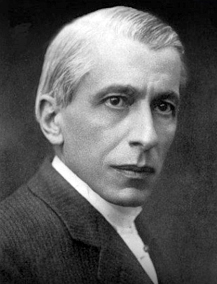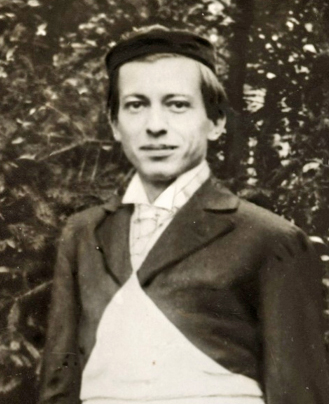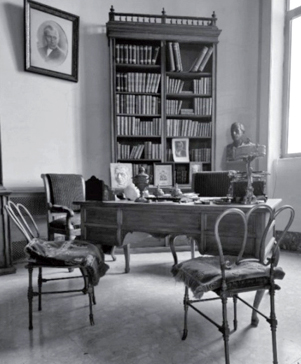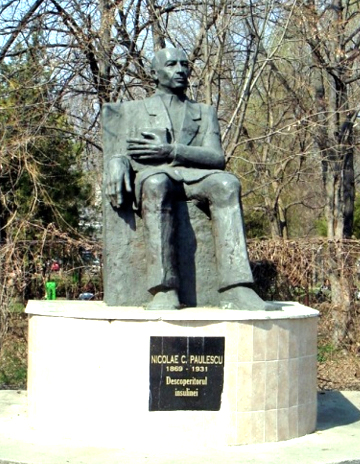|
||||||||||||||||||||||||||||||||||||
| [
Contents
] [ INDEX ]
|
||||||||||||||||||||||||||||||||||||
|
Page 163 |
||||||||||||||||||||||||||||||||||||
|
History of medicine Nikolae Paulesku - an unrecognized fighter in the treatment of diabetes Srðan Petkoviæ (1), Goran Krstiæ (2), Milan Jovanoviæ (1,3) (1) CLINIC FOR GENERAL SURGERY, MILITARY MEDICAL ACADEMY, BELGRADE, SERBIA; (2) DEPARTMENT OF INTERNAL DISEASES, MILITARY HOSPITAL NI©, NI©, SERBIA; (3) FACULTY OF MEDICINE, UNIVERSITY OF DEFENSE, BELGRADE, SERBIA |
||||||||||||||||||||||||||||||||||||
|
|
||||||||||||||||||||||||||||||||||||
| Download in pdf format | Summary: Taking into
account the number of people suffering from diabetes all over the
world, it is understandable that there is a great interest in
discovering the disease and its cause, as well as in finding an
adequate therapy. Although the first data on diabetes date back to
around 500 BC, it was first scientifically confirmed and described
only at the end of the 19th century. In 1923, the Nobel Prize for
the discovery of insulin was awarded to McLeod and Bunting, but the
name of another doctor should be closely associated with this
important discovery. It is prof. Nicolae Paulescu, a famous Romanian
doctor, scientist and reformer of the educational system in this
country. He devoted his entire career to research in medicine and
adequate education of young people. Prof. Paulescu made the greatest
contribution in the field of endocrinology when in 1921 he presented
his studies on the effect of pancreatic extract on animals suffering
from diabetes, which was equivalent to the discovery of insulin.
However, the reward for this achievement was received by other
scientists discrediting his contribution, and they found cover for
it in his political views. Key words: Nicolae Paulescu, diabetes, insulin. |
|||||||||||||||||||||||||||||||||||
|
The history of discovering and trying to treat diabetes goes back
thousands of years. The disease was first recorded in Ancient Egypt
on a papyrus discovered in 1862, and diabetes was described as a
disease characterized by strong thirst and excessive urination.
Sanskrit writings (around 500 BC) describe the urine of the patient
as "honey" [1]. Although it has been known for a long time, the disease was experimentally studied and described only at the end of the 19th century, when it was proven that the pancreas plays a central role in the development of this disease. The role of the pancreas in glucose metabolism, as well as the discovery of insulin, were not clarified until 1921, when Sir Frederick Bunting and Charles Best proved that in dogs without a pancreas, diabetes could be prevented by giving an extract from the islets of Langerhans of the pancreas of healthy dogs. They managed to isolate insulin from the pancreas of beef at the University of Toronto, to purify it for clinical use, which made it possible to use it in the therapy of diabetes. Two years later, in 1923, the Nobel Committee for Medicine awarded the prize for the discovery of insulin to laboratory director McLeod and Bunting [2]. That history knows how to sometimes play rough with people, who have dedicated their lives to science and research, is shown by the case of prof. Dr. Nicolai Paulescu, a man who is not recognized for his discovery of insulin. Picture 1-Nicolae Paulescu
The famous Romanian scientist, doctor and professor Nicolae
Paulescu was born on October 30, 1869 in Bucharest. His family was
well known in their community and benefited from aristocratic
status. His father, Constantin Paulescu, a prominent merchant in
Bucharest, represented the merchant class in the Romanian
Parliament. His two daughters, Elena and Constanta, were alumni of
the Bucharest Conservatory of Music, while the eldest, Nicolae
Paulescu, is better known for his medical career [3]. Picture 2-Nicolae Paulescu in Paris in 1897
In 1900, motivated by his patriotic, religious principles and
homesickness, he returned to Romania where he assumed an active
leadership role in the national reform of the educational, medical
and research system. He left a deep mark on French medicine. He
became a member of the French Academy and was awarded the Order of
Academic Palms. Even more impressive is the fact that Notre Dame de
Perpetuel Secours Hospital once a year offered two internship
positions to Romanian students directly recommended by Nicolae
Paulescu. This tradition continued even after his death.
Unfortunately, it ended in 1940 after the outbreak of World War II
[3,4]. Picture 3 - Nicolai Paulescu's original office preserved in the Nicolai Paulescu Museum at the "Carol Davila" University of Medicine and Pharmacy in Bucharest
The next step was marked by the isolation of the "aqueous extract
of the pancreas" in 1916, or as he called it pancrein. By injecting
the extract into the jugular vein of dogs with pancreatectomy-induced
diabetes, he observed that the pathological blood glucose level
temporarily returned to normal. However, the insufficient purity of
pancrein extract made it unusable for human consumption. Shortly
after the end of these experiments, Paulescu was mobilized into the
Romanian army, due to the upcoming Hungarian-Romanian war
(1918-1919). After the war, starting in July 1921, he published four
articles in which he described his research, the last of which, the
most detailed, appeared at the end of August 1921 [3,7]. Picture 4 - Statue of Nicolai Paulescu in front of the Faculty of Medicine in Bucharest
However, all these findings were not recognized as revolutionary
by the medical luminaries of the time. The news that the Nobel Prize
was awarded to the Canadian team further radicalized his
socio-political views in the context of his time (emergence of
National Socialism), publishing some far-right articles and books
[5]. This radicalization proved useful to his rivals in terms of
discrediting Paulesque's scientific contributions. He died in full
academic maturity and creative activity at the age of 62, on July
27, 1931. He was buried in the White Cemetery in Bucharest.
Posthumously, in 1990, he was elected a member of the Romanian
Academy. LITERATURE:
|
||||||||||||||||||||||||||||||||||||
|
|
||||||||||||||||||||||||||||||||||||
| [
Contents
] [ INDEX ]
|
||||||||||||||||||||||||||||||||||||
|
||||||||||||||||||||||||||||||||||||




